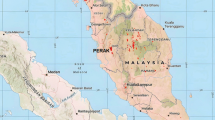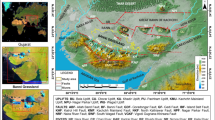Abstract
Insular ecosystems can be dramatically affected by alien species, and records of pre-eradication status are essential to evaluate the effects of eradicating alien species. Nishi-jima Island is a small island of the Ogasawara group on which the first program of complete eradication of alien herbivorous mammals (black rats and feral goats) will be conducted. After eradication, the government plans to conduct ecosystem restoration on the island. This paper reports the angiosperm flora and vegetation of Nishi-jima Island before eradication of the rats and goats, with the objective of aiding ecosystem management after the eradication. Our surveys indicate that vegetation cover by the alien tree, Casuarina equisetifolia has expanded compared with its distribution in a 1974 aerial photograph of the island. The predominant vegetation in 2006 was C. equisetifolia forests and Zoysia tenuifolia grasslands, with fragmented native tree vegetation. The flora of the island comprised 69 angiosperm species (50 indigenous species) of which 30% were endemic, far less than for the Ogasawara Islands as a whole (45%). However, several populations of endangered plants remain. To restore the native ecosystem on Nishi-jima, eradication of C. equisetifolia is important in addition to eradication of alien herbivorous mammals.





Similar content being viewed by others
References
Abe T (2007) Predator or disperser? A test of indigenous fruit preference of alien rats (Rattus rattus) on Nishi-jima (Ogasawara Islands). Pac Conserv Biol 13:213–218
Abe T, Umeno H (2011) Pattern of twig cutting by introduced rats in insular cloud forests. Pac Sci 65:27–39
Ashton IW, Hyatt LA, Howe KM, Gurevitch J, Lerdau MT (2005) Invasive species accelerate decomposition and litter nitrogen loss in a mixed deciduous forest. Ecol Appl 15:1263–1272
Bellingham PJ, Tanner EVJ, Healey JR (2005) Hurricane disturbance accelerates invasion by the alien tree Pittosporum undulatum in Jamaican montane rain forests. J Veg Sci 16:675–684
Brown KA, Scatena FN, Gurevitch J (2006) Effects of an invasive tree on community structure and diversity in a tropical forest in Puerto Rico. For Ecol Manag 226:145–152
Coblentz BE (1978) The effects of feral goats (Capra hircus) on island ecosystems. Biol Conserv 13:279–286
Cordell S, Ostertag R, Rowe B, Sweinhart L, Vasquez-Radonic L, Michaud J, Cole TC, Schulten JR (2009) Evaluating barriers to native seedling establishment in an invaded Hawaiian lowland wet forest. Biol Conserv 142:2997–3004
Courchamp F, Chapuis JL, Pascal M (2003) Mammal invaders on islands: impact, control and control impact. Biol Rev 78:347–383
Enomoto T (1992) Weeds and alien plants in Chichi-jima and Haha-jima, Ogasawara Islands. Ogasawara Kenkyu Nenpo 16:3–17 (in Japanese)
Environmental Agency (1979) The 2nd national survey on the natural environment (vegetation). Environmental Agency, Tokyo (in Japanese)
Fine PVA (2002) The invasibility of tropical forests by exotic plants. J Trop Ecol 18:687–705
Government of Japan (2010) Nomination of the Ogasawara Islands for inscription of the World Heritage List. Government of Japan, Tokyo
Hamann O (1979) Regeneration of vegetation on Santa Fé and Pinta Islands, Galápagos, after the eradication of goats. Biol Conserv 15:215–236
Hashimoto T (2009) Eradication and ecosystem impact of rats in the Ogasawara Islands. Chikyu Kankyo 14:93–101 (in Japanese)
Hata K, Kachi N, Ichikawa S (2006) Invasion process of alien woody species, Leucaena leucocephala after the eradication of feral goats in the Naoudo-jima Island. Ogasawara Kenkyu Nenpo 29:7–17 (in Japanese)
Hata K, Suzuki J, Kachi N (2007) Vegetation changes between 1978, 1991 and 2003 in the Nakoudojima Island that had been disturbed by feral goats. Ogasawara Res 32:1–8
Hata K, Kato H, Kachi N (2009) Community structure of saplings of native woody species under forests dominated by alien woody species, Casuarina equisetifolia, in Chichijima Island. Ogasawara Res 34:33–50
Hughes PF, Denslow JS (2005) Invasion by a N2-fixing tree alters function and structure in wet lowland forests of Hawaii. Ecol Appl 15:1615–1628
La Maitre DC, van Wilgen BW, Chapman RA, McKelly DH (1996) Invasive plants and water resources in the western Cape Province, South Africa: modeling the consequences of a lack of management. J Appl Ecol 33:161–172
Lowe S, Browne M, Boudjelas S, De Poorter M (2000) 100 of the World’s worst invasive alien species: a selection from the Global Invasive Species Database. ISSG and IUCN, Auckland
Meyer JY, Florence J (1996) Tahiti’s native flora endangered by the invasion of Miconia calvescens DC. (Melastomataceae). J Biogeogr 23:775–781
Ministry of the Environment (2007) Red list of plants and Red Data Book. Official web site of Ministry of the Environment. Available via http://www.biodic.go.jp/rdb/rdb_f.html. Accessed 24 Sept 2008 (in Japanese)
Mueller-Dombois D, Fosberg FR (1998) Vegetation of the tropical Pacific islands. Springer, New York
Nichols JD, Williams BK (2006) Monitoring for conservation. Tree 21:668–673
Okutomi K, Iseki T, Hioki Y (1981) Vegetation of the Chichi-jima Archipelago and Haha-jima Archipelago (Ogasawara). Tokyo Vegetation Research Society, Tokyo (in Japanese)
Parrotta JA (1995) Influence of overstory composition on understory colonization by native species in plantations on a degraded tropical site. J Veg Sci 6:627–636
Shimizu Y (1986) Serious damage to Pinus luchuensis by the attack of the pine wood nematode at Chichijima in the Bonin (Ogasawara) Islands. J Fac Lett Komazawa Univ 44:169–178
Shimizu Y, Tabata H (1985) Invasion of Pinus lutchuensis and its influence on the native forest on a Pacific island. J Biogeogr 12:195–207
Sugiura S, Tsuru T, Yamaura Y, Hasegawa M, Makihara H, Makino S (2008) Differences in endemic insect assemblages among vegetation types on a small island of the oceanic Ogasawara Islands. Entomol Sci 11:131–141
Sugiura S, Tsuru T, Yamaura Y, Makihara H (2009) Small off-shore islands can serve as important refuges for endemic beetle conservation. J Insect Conserv 13:377–385
Toyoda T (2003) Flora of the Bonin Islands, 2nd edn. Aboc sha Co. Ltd, Kamakura (in Japanese)
Tuttle NC, Beard KH, Pitt WC (2009) Invasive litter, not an invasive insectivore, determines invertebrate communities in Hawaiian forests. Biol Invasions 11:845–855
Yabe T, Hashimoto T, Takiguchi M, Aoki M, Fujita M (2010) Twig cutting by the black rat, Rattus rattus (Rodentia: Muridae) on the Ogasawara Islands. Pac Sci 64:93–97
Yamashita N, Tanaka N, Hoshi Y, Kushima H, Kamo K (2003) Seed and seedling demography of invasive and native trees of subtropical Pacific islands. J Veg Sci 14:15–24
Yoccoz NG, Nichols JD, Boulinier T (2001) Monitoring of biological diversity in space and time. Tree 16:446–453
Acknowledgments
We thank Jun Maesawa and Yui Ishigami for field assistance, and anonymous referees for helpful comments. The National Forest Division of the Ogasawara General Office permitted us to use the study site. This study was partially supported by the Ministry of the Environment (Global Environmental Research Coordination System).
Author information
Authors and Affiliations
Corresponding author
Appendix
Appendix
See Table 3.
About this article
Cite this article
Abe, T., Yasui, T. & Makino, S. Vegetation status on Nishi-jima Island (Ogasawara) before eradication of alien herbivore mammals: rapid expansion of an invasive alien tree, Casuarina equisetifolia (Casuarinaceae). J For Res 16, 484–491 (2011). https://doi.org/10.1007/s10310-010-0239-0
Received:
Accepted:
Published:
Issue Date:
DOI: https://doi.org/10.1007/s10310-010-0239-0




